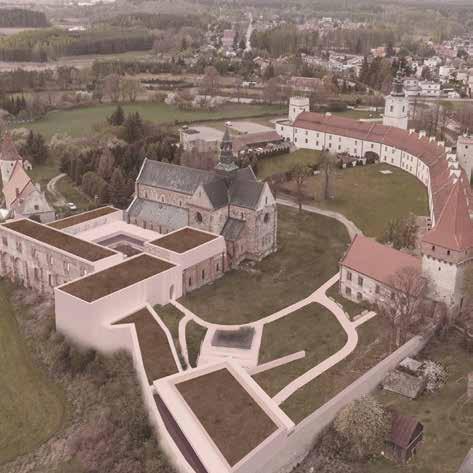
1 minute read
NOMINACJA / NOMINATION MARIA PĄCZEK
TYTUŁ / TITLE:
Projekt Muzeum Cystersów z Centrum Medytacji w Ruinach Dawnego Klasztoru Cystersów w Sulejowie / Cistercian Museum and Meditation Centre in the Ruins of the Former Cistercian Monastery in Sulejów
Advertisement
PROMOTOR / SUPERVISOR: dr hab. inż. arch. Anna Bojęś-Białasik, prof. PK
STRESZCZENIE:
Tematem pracy dyplomowej jest jeden z najstarszych klasztorów cysterskich w Polsce – zespół klasztorny w Sulejowie. Obecnie obok kościoła cysterskiego pełniącego funkcję świątyni parafialnej znajdują się ruiny zespołu klasztornego. Projekt poprzedzony szczegółową analizą historyczną pocysterskiego zespołu, oraz potrzeb nielicznego ale funkcjonującego tutaj konwentu cystersów. Zaproponowano restytucję klasztoru w oparciu o tradycyjny model cysterskiego claustrum, z wykorzystaniem zachowanych reliktów architektonicznych. Do wzniesienia nowych struktur wykorzystano syntetyczne i minimalistyczne środki architektonicznego wyrazu a także nawiązano do lokalnego kamienia zastosowanego w oryginalnym obiekcie. Ważnym aspektem pracy jest odwołanie się dyplomantki do prostoty pragmatyczności cysterskiego budownictwa, osadzonego mocno w ich zasadach funkcjonowania. W klasztorze umieszczono Muzeum Kultury Duchowej Cystersów oraz Centrum Medytacji.
ABSTRACT:
The subject of this thesis project is one of the oldest Cistercian monasteries in Poland – the monastic complex in Sulejów. At present, apart from a Cistercian parish church, it features the ruins of a monastic complex. The design was preceded by a detailed historical analysis of the complex and the needs of the small yet still operating Cistercian monk community. A restoration of the monastery based on a traditional model of the Cistercian cloister, which incorporated the surviving architectural remains, was proposed. Synthetic and minimalist means of architectural expression were used to erect the new structures, and references to local stone used in the original building were included. Referencing the simplicity and pragmaticism of Cistercian architecture, with a strong basis in the principles of their functioning, was a key aspect of the project. A museum of the Spiritual Culture of the Cistercians and a Meditation Centre were incorporated into the monastery.












